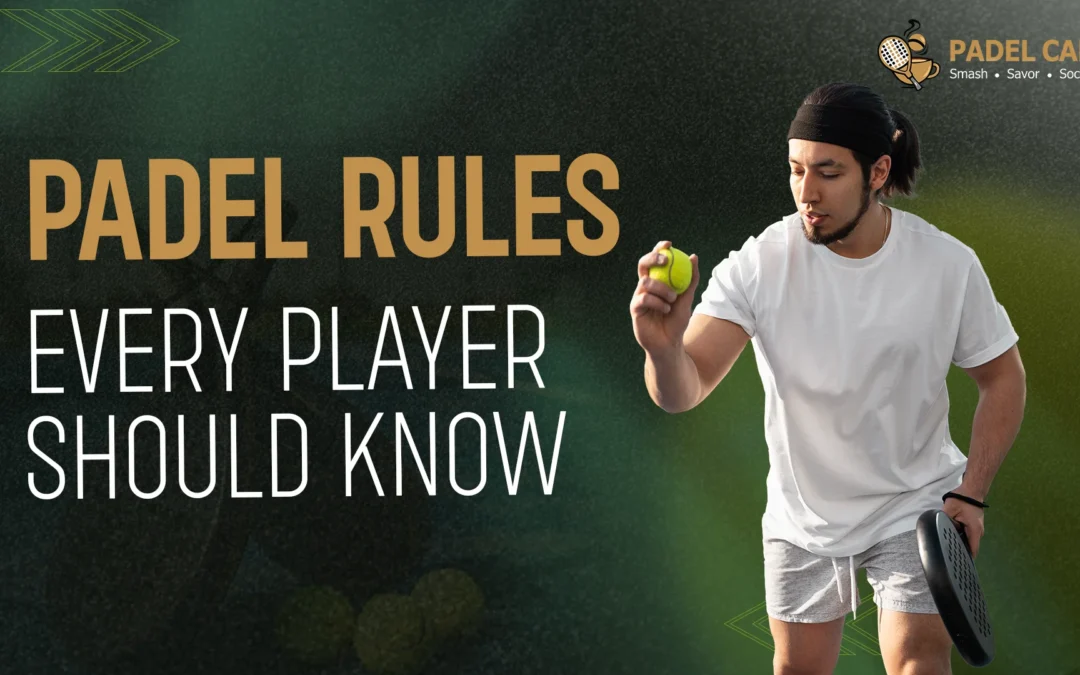What’s a game without any rules?
Any, whether a proper sport or some household child play, is based on some rules, serving as the foundation of game winning or losing. Likewise, padel, an exciting and fast-growing sport with popularity across the globe, also comes with a set of defined rules by which all players need to abide.
So, if you’re a beginner and are up to learning the game’s rules, we’ve got you covered. Here, we offer a breakdown of the fundamental Padel rules that govern the game’s unfolding.
Basic Considerations
Starting with the basics, the following are the key considerations the players must know of:
- No. of players: padel is always played in doubles, i.e., a 4-player game.
- Serves: The serves are always underhand.
- Score: Padel imports the scoring system of tennis.
- Ball: Like tennis balls but different. The Padel ball is a bit smaller in size, with a comparatively smoother felt, giving them a lower bounce.
- Padel: A no-string solid racket with perforations
- Walls: The glass walls are a part of the game.
Essential Padel Rules
Now, take a deeper dive and understand what it takes to win a Padel tennis game.
1. The Game Dynamics
Adhering to basic game dynamics is important for continuing a mistake-free game.
Rule 1: Position of the Players
- The game is played by players who can stand anywhere in the space between the serving line and the net. Players should avoid the “no man’s land.”
- The players change court sides as they play an odd number of games.
Rule 2: Choice of Court Side and Serve
- The players choose their side of the court with a draw. The team winning the draw gets to decide:
- Their side of the court (the opponent decides who will serve first).
- Who will make the first serve (here, the opponent can choose their side of the court)
- Requesting the opponents to choose first.
2. The Serve
There’s a lot more to the serve than just hitting the ball underhand before striking.
Rule 1: Serving dynamics
- The player’s feet should be slightly behind the service line, with the ball hitting the baseline.
- Like tennis, the serve is cross-quadrant, i.e., the served diagonally over the net and into the opponent’s service area.
- The first serve is done from the right-hand side, after which the serving is done from the alternate side (diagonally).
- The server should not stand in the center of the ‘no man’s land’* when serving.
- The player should hit the ball below the waist level (underhand serve).
Note: A disabled player with one arm can bounce the ball on the ground with the racket.
*No man’s land: The area between the baseline and the net position.
- When serving, the player should have one foot completely on the ground.
- If the player misses the serve-hit, the service is still considered as taken.
- If service is done inadvertently from the wrong side, the points earned remain valid.
Good Serve: The ball bounces twice in the opponent’s courts after it hits the back wall. The serve is also good when the ball hits the edge line between the back and the lateral wall and still comes back in the direction of the receiving players.
Rule 2: Service Faults
- The player misses the ball when serving.
- The served ball bounces out of the opponent’s serving area.
- The served ball hits the opponent.
- The ball touches one of the walls of the server’s court, even if it later bounces over the net into the opponent’s service area.
- The server takes more than 25 seconds to serve after a preceding point.
- The server’s feet touch the service line or are beyond the serve line when serving.
Rule 3: Service Order
- The players with a right to serve in the first game of every set decide which of the two teammates will serve first.
- Near the end of the first game, the receiving pair starts serving, and this alteration continues for all games of the set.
- As a new set begins, players with the right to serve decide who among the partners will serve first, and then it’s taken in turns.
- If a player serves out of turn, the other one immediately takes the turn as soon as the fault is discovered. All the points before the discovery of the ‘error’ are valid. If that’s the only error before the set ends, and the error is not discovered, the game continues with the same ‘incorrect’ service turns.
Rule 4: No. of Serves
- The server is allowed a second serve if the first one counts as an invalid serve. The second serve is made from the same direction as the first serve.
Rule 5: Preparation of the Receiver
- The server should not serve until the receiver is not ready for a shot. However, the receiver should respect the 25-second interval rule and be ready within this time frame.
3. Service Return
While there are rules for the serving players, there are also rules for the player who receives it.
Rule 1: The return of serve
- The receiving player should wait to hit until the ball bounces once in the court.
Rule 2: Return Order
- The players with a right to receive in the first game of every set decide which of the two teammates will receive the serve first.
- The players take turns in receiving the serve in every set. Once the order is decided, it remains unchanged till the beginning of the new set.
- If the players alter the order of receiving the serve during the game, the game continues in the same order until the error is discovered. All points are earned until they are valid. If the error remains undiscovered, the game continues.
Rule 3: The “Let Ball” Play
A “Let” ball is when the ball touches the net during the serve and lands fairly in the receiver’s court.
- The ball touches the net or the net posts and then bounces in the receiver’s court without hitting the wall.
- The ball has touched the net or the net post inside the area of the play and bounces off to touch either the receiving player or the player’s body part.
- When the receiving player is not ready for the shot.
- The player can only serve once if the “Let” occurs in the second service.
Rule 4: The “Let Point”
- The ball splits into half during the game.
- The game stops due to unprecedented circumstances.
4. Scoring
The Padel sport takes on the scoring strategy of tennis.
Rule 1: Scoring Points
- Points are scored as follows:
- 0 (love)
- 15 (as the pair wins the first point).
- 30 (as the pair wins the second point).
- 40 (as the pair wins the third point).
- The fourth point marks the end of the game if only one pair has won the third point. If both pairs have had 3 points, then the third point is called 40-40 or 40-all or deuce.
- The point next to deuce is called “advantage” and goes in favor of the team scoring it.
- The point next to the advantage is the winning point, with which the game ends.
- The winning point is lost, the game returns to deuce, and it continues until the team scores two executive points after it.
- A team wins the set if it’s the first one to win all 6 games of a set with a minimum of two advantage points.
- In case of a 5-all draw, the players play two more games, and the team scoring the next two points first, making 7-5 wins.
- In case of a 6-6 draw, the pair scoring the two-game advantage wins unless the tie-break (7-6) has already been played. Players are allowed to make moves.
5. During the Game
During the game, there are a couple of allowed moves that the players can make to hit the ball and score a point, provided the ball bounces only once.
Rule 1: Ball in Play
- The ball remains in play from the moment it’s served and remains so until a team scores a point.
- A player can hit the ball in the opponent’s upper court limits (near the net), make it bounce once, and then leave the court immediately.
- For this purpose, the court should have entrances (0.82 x 2 meters and a minimum of 0.72 x 2 meters) on both sides, with no solid object exterior to it.
- The players can strike the ball after it bounces off the walls of the court, except in service play.
Rule 2: Volley
- The players can play volley and take the ball in the air except in the serve or when receiving the serve.
Rule 3: Play on Court Installations
- The ball remains in play if it bounces against any court installations and then bounces back into the court.
- If the ball bounces off the roof or the lights, the point’s finished, and the ball is no longer in play.
Rule 4: Continuous Play
- The play is continuous from the first serve till the end of the match except during:
- The allowed intervals.
- When changing court sides.
- In matches of 5 sets when there’s a 10-minute break.
- The match is never delayed, suspended, or interrupted to give the players time to unwind and reenergize or to give them instructions.
Rule 5: Lost Point
The point is lost when:
- The players’ racquets or anything they hold, or wear touch the net.
- The ball bounces twice in the court prior to being returned.
- The ball is volleyed before it passes over the net.
- The players touch the ball when hitting with the racket.
- Both players hit the ball simultaneously or consecutively.
Rule 6: Ball Changes
The ball is changed during the matches as follows:
- The third set starts, but not in the finals and semi-finals.
- In semi-finals and finals:
- First change after the first 11 games.
- The next ball changes after 13 games and then successively.
- In other matches, the ball is changed after a set of games (usually odd in number). The warm-up period makes two games, while the tie-break counts as one game.
Rule 7: Rest Intervals
- In 5-set matches, an additional 10-minute break after the 3rd set.
- Between two points, a maximum of 20-second break.
- A 90-second break to change sides.
- A maximum break of 120 seconds after every set.
- Up to 15 minutes in case of any injury.
Final Words
Rules and regulations are defined for all games, and they have been for the Padel sport. It helps ensure a fair game among the players. Knowing and following these also instill integrity in the players, who then successfully finish off a smooth game with a good handshake. However, the game is also about fun and thrill, so, the players should strive to enjoy the game as well, ensuring to abide by the game’s rules.

